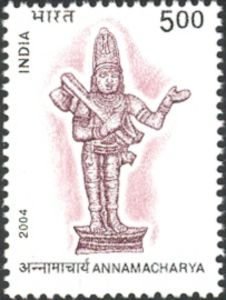
Number #10 in our Carnatic Postage Stamp Series is a commemorative stamp issued on 18th March, 2004 to celebrate Annamacharya. Annamacharya was a 15th-century Hindu saint and the earliest known Indian musician to compose songs called sankirtanas in praise of the god Venkateswara.He is the first known composer in carnatic music.
The following is from the Information Folder issued by Indian Posts & Telegraph Department, Government of India
“Brahmam is supreme. The entire creation is one and the same. God does not differentiate the big from the small… The Brahmin and the pariah tread on the same earth. The day and night are identical for the rich and the poor… Similarly, devotion to Venkateshwara protects the pious and the sinner alike….”
Thus flashed the light of faith from the soul stirring ‘Sankirtanams’ of Annamacharya, the 15th century mystic saint, social reformer, “Sahaja Vaggeyakara” (singer-poet) and above all, an ardent devotee of Lord Venkateshwara. Born in 1408to Lakkamamba and Narayana Suri in Rajampet Taluq of Cuddappah District of Andhra Pradesh, he was named Annamayya because he was born by the grace of ‘Nandaka’, the mighty sword of Lord Vishnu.
At a tender age, Annamayya left home in search of Tirumala, the abode of Lord Venkateshwara along with a ‘Tanpura’ in his hand. On his way to Tirumala, he composed and rendered spontaneously, a hundred verses dedicated to the glory of Alamelu Manga, consort of Lord Venkateshwara. At Tirumala, he was initiated into Srivaishnavism by sage Ghana Vishnu,thus transforming Annamayya into Annamacharya. At the age of 16th, Annamacharya got married and became a Grihastha, a householder.
It is said that in 1424 AD, Lord Venkateshwara appeared before Annamacharya when he was immersed in divine contemplation. The Lord heard a song that emerged from his voice and expressed a desire that He should hear a new composition everyday from Annamacharya From that day onwards Annamacharya carried this Sankirtana Yagna to his last breath. The sankirtanams were embedded with rich idiom, native vocabulary, powerful expression and divine philosophy. According to Chinna Tirumalacharya, grandson of Annamacharya, he composed 32,000 sankirtanams for guiding human beings to disregard Varna differences and to attain God. His social outlook and his musical contribution were deeply rooted in his devotion.
Annamacharya’s sankirtanams are categorized into Sringara (Madhura Bhakti) and Adhyatma (Deergha Saranagati). While ‘Sringara sankirtanams’ express ‘amalina sringaram’ (unadulterated love) between souls, much like the love of Gopikas for Lord Krishna, the ‘Adhyatma sankirtanams’ contain Bhakti and Prapatti. It was through Adhyatma sankirtanams that Annamacharya advocated an egalitarian society. At the same time, the devotional character and depth of his sankirtanams can be gauged from the fact that they constitute part of the temple routine at Tirumala temple since the Lord wakes up to his Melukolupu (Morning song) and retires to bed with his Jola Pata (Lullaby). Apart from sankirtanams, Annamacharya wrote ‘Sringara Manjari’ (Manjari Dwipada), ‘Dwipada Ramayana’. ‘Venkatachala Mahatyam’, ‘Sankirtana Lakshanam’and 12 Satakanis. Thus, in the Telegu literary world, Annamacharya was acclaimed as ‘Sankirtanacharya’, ‘Pada Kavita Pitamaha’ and ‘Dravidagana Sarvabhouma’. All his works were engraved on thick copper plates, many of which have now been melted by ignorant and greedy people. Thus, all but one Sataka and 14,400 sankirtanams were lost with the passage of time.
Annamacharya was the pace-setter of Carnatic music. He discarded orthodoxical exigencies and systematized Sankirtanas. He evolved his own style in pallavi and charanams and attained absolute unity of Raga – Bhava – Tala. While pallavi contained the central idea, charanams elaborated upon the theme contemplated in pallavi. Purandaradasa, the famous Carnatic musician of the 15th century, who met Annamacharya, declared that his sankirtanams were not mere songs but were sacred hymns with extensive curative power.
It is also said that the popularity of this divine singer arrested the attention of a Vijayanagara chieftain called Saluva Narasingaraya. One day the king invited Annamacharya to his court and requested him to render one of his recent compositions. The king was thrilled by the mellifluous music and requested the saint to compose one such song in his favour. Annamacharya made it clear that his soul which was dedicated to ‘Narahari’ (God) would not yield to ‘Nara’ (Man). The King felt humiliated and locked him up in the prison. But the unperturbed devotee of Vishnu appealed to Lord Venkateshwara in absolute surrender. The song of the saint, through a magic spell of Lord Venkateshwara reportedly, broke the chains. The King realised his mistake and fell at the feet of Annamacharya.
Annamacharya’s soul departed from the world in 1503 AD at the age of95 years. Before his departure, Annamacharya handed over the ‘Tanpura’ he held, to his son Peda Tirumalaiah and guided him to carry forward the mission he had started. Annamacharya may have left the mortal world but his immortal songs still reverberate in the sacred peaks of Venkatachalam.
The Department of Posts pays a tribute to this mystic saint through the release of a commemorative postage stamp.
Credit – http://www.indianphilatelics.com/…/14301-annamacharya-click…
Also read
https://en.wikipedia.org/wiki/Annamacharya
for more information on Annamacharya!
#Carnatic #Postage #Stamp #Series #CarnaticPostageStampSeries
Next week, we’ll cover V. Lakshminarayana. Following the Guru Shishya parampara flowing from Baluswamy Dikshitar, V. Lakshminarayana is credited with introducing and adapting a Western violin to Indian music. He is the father of contemporary musicians L. Subramaniam and L. Shankar. Until then, have a great week! Stay safe and well!

